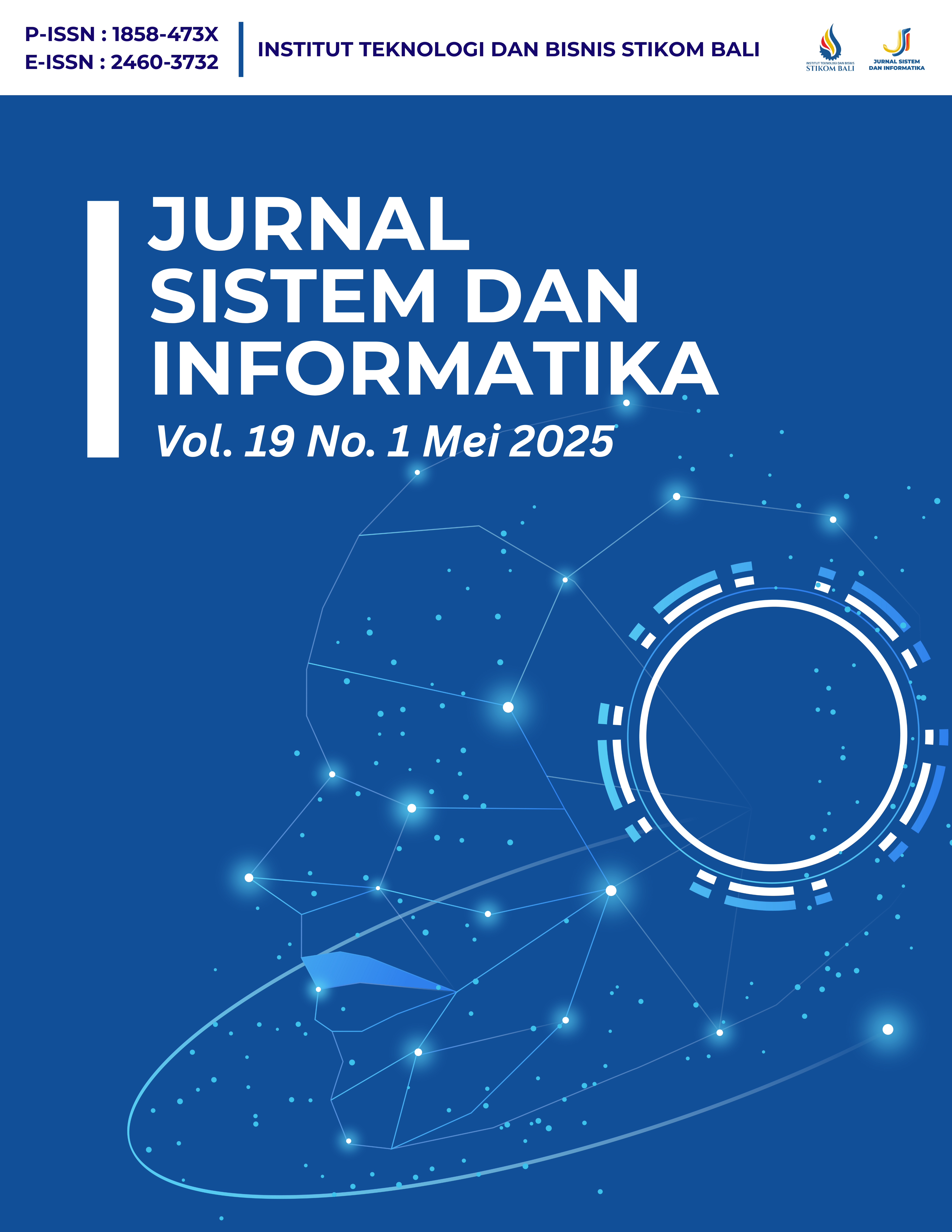Evaluation of IT-Based SCM System Using the DeLone and McLean Model
Main Article Content
Abstract
This qualitative case study evaluates the effectiveness of the IT-based Supply Chain Management (SCM) information system developed at PT Hifni Jaya Makmur (PT HJM), a medium-scale agricultural commodity company specializing in coffee and black pepper. The company faces challenges, including seasonal fluctuations in raw material supply and limited vehicle availability for deliveries. To address these issues, a digital SCM system was implemented, featuring key features such as demand forecasting using the Single Exponential Smoothing (SES) method, safety stock calculation, and delivery monitoring. The evaluation was conducted using the DeLone and McLean Information System Success Model, which involves six dimensions: system quality, information quality, service quality, usage, user satisfaction, and net benefits. Data were collected through triangulation of interviews, observations, and system documentation. Findings indicate that the system significantly improved procurement accuracy, reduced processing time, and enhanced delivery planning. However, further enhancements such as multi-period forecasting, automated vehicle scheduling, and integration with external data sources are recommended to increase the system's effectiveness.
Article Details

This work is licensed under a Creative Commons Attribution-ShareAlike 4.0 International License.
Jurnal Sistem dan Informatika (JSI) bersifat open access, yaitu dapat diakses secara umum tanpa dikenakan biaya. Penulis yang menerbitkan artikelnya di JSI setuju dengan ketentuan berikut:- JSI menggunakan perjanjian lisensi ekslusif, yaitu penulis memegang hak cipta atas artikel dan memberikan hak publikasi kepada Jurnal Sistem dan Informatika (JSI).
- JSI mempunyai hak ekslusif untuk mempublikasi dan mendistribusikan artikel secara sebagian atau keseluruhan, dan memberikan hak kepada orang lain sesuai dengan lisensi yang digunakan.
- JSI berhak untuk menyediakan artikel dalam berbagai bentuk dan media, sehingga artikel dapat digunakan untuk teknologi terbaru bahkan setelah dipublikasikan.
- JSI berhak untuk menegakkan hak-hak atas nama penulis pada artikel terhadap pihak ketiga. Misalnya dalam kasus plagiarisme atau pelanggaran hak cipta.
- Artikel harus dirujuk, link terhadap lisensi harus disediakan, dan jika terdapat bagian artikel yang diubah harus ditandai.
- Jika artikel disadur sehingga terdapat perubahan, hasil saduran harus didistribusikan menggunakan lisensi yang sama.
- Tidak diperkenankan untuk membatasi orang lain terhadap apa yang diperbolehkan oleh lisensi.
References
[2] M. Al-Talib, W. Al-Saad, A. Alzoubi, and A. I. Anosike, “A systematic review of the literature on the use of information technologies in supply chain management,” Int. J. Ind. Eng. Oper. Manag., ahead-of-print, 2024, doi: 10.1108/IJIEOM-09-2023-0073.
[3] F. Ciampi, M. Faraoni, J. Ballerini, and F. Meli, “The co-evolutionary relationship between digitalization and organizational agility: Ongoing debates, theoretical developments and future research perspectives,” Technol. Forecast. Soc. Change, vol. 176, p. 121383, 2022, doi: 10.1016/j.techfore.2021.121383.
[4] I. P. P. Damana, I. M. Candiasa, and I. G. A. Gunadi, “Analisis kesuksesan sistem informasi online (SION) menggunakan metode Delone and Mclean,” MALCOM: Indonesian Journal of Machine Learning and Computer Science, vol. 3, no. 2, pp. 331–338, 2023, doi: 10.57152/malcom.v3i2.958.
[5] D. N. Maftuhah et al., “Knowledge management system evaluation using DeLone McLean model: A case study of IT service desk Bank XYZ,” J. Nas. Pendidik. Tek. Inform. (JANAPATI), vol. 12, no. 2, pp. 223–233, 2023, doi: 10.23887/janapati.v12i2.59609.
[6] S. A. Dewanti and W. Santosa, “The effect of absorptive capacity on supply chain innovation performance through supply chain agility in manufacturing companies in Bogor, Indonesia,” Golden Ratio of Marketing and Applied Psychology of Business, vol. 5, no. 2, pp. 414–425, 2025, doi: 10.52970/grmapb.v5i2.983.
[7] A. Gozali and J. Supranto, “Evaluasi implementasi Enterprise Resources Planning pada perusahaan manufaktur dengan model DeLone dan McLean,” J. Manaj. Bisnis dan Kewirausahaan, vol. 4, no. 2, p. 21, 2020, doi: 10.24912/jmbk.v4i2.7516.
[8] J. Liu, W. Yeoh, Y. Qu, and L. Gao, “Blockchain-based digital twin for supply chain management: State-of-the-art review and future research directions,” Sustainability, vol. 14, no. 15, p. 9497, 2022. [Online]. Available: https://www.mdpi.com/2071-1050/14/15/9497
[9] J. Mageto, “Big data analytics in sustainable supply chain management: A focus on manufacturing supply chains,” Sustainability, vol. 13, no. 13, p. 7101, 2021, doi: 10.3390/su13137101.
[10] I. Murniasih and A. D. Wiranata, “Development of asset inventory management information system using the Delone and Mclean success model approach,” Infotech: J. Technol. Inf., vol. 10, no. 2, pp. 289–298, 2024, doi: 10.37365/jti.v10i2.321.
[11] L. Murphy, “Designing a supply chain visibility information system for the manufacturing industry,” IPTEK: J. Eng., vol. 9, no. 3, p. 101, 2023, doi: 10.12962/j23378557.v9i3.a17426.
[12] S. O. Rakhman, “Analisis kesuksesan aplikasi mobile CRM menggunakan metode DeLone and McLean: Studi kasus,” Multinetics, vol. 9, no. 2, pp. 165–173, 2024, doi: 10.32722/multinetics.v9i2.6476.
[13] F. B. Rivera, A. Wulansari, and E. M. Safitri, “Penerapan model DeLone & McLean dalam menilai kesuksesan dan kapabilitas pengguna sistem informasi di industri logistik,” J. Teknol. Sist. Inf. dan Apl., vol. 7, no. 3, pp. 1407–1417, 2024, doi: 10.32493/jtsi.v7i3.41981.
[14] N. Seliana, A. I. Suroso, and L. N. Yuliati, “Evaluation of e-learning implementation in the university using Delone and Mclean success model,” J. Apl. Manaj., vol. 18, no. 2, pp. 345–352, 2020, doi: 10.21776/ub.jam.2020.018.02.15.
[15] I. Purnomo, “Evaluating the success of ERP implementation in Indonesia: Delone and Mclean model approach,” in Proc. Int. Conf. Economics, Business Management, and Accounting (ICOEMA), vol. 3, pp. 63–72, 2024.




